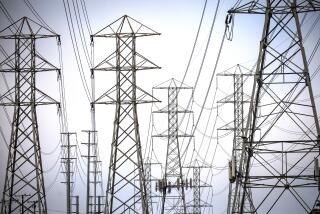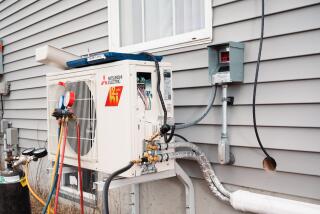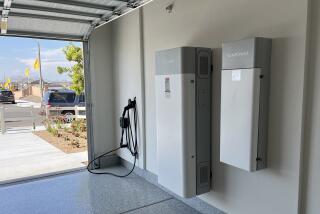Sensible Ways to Cut Down on the Kilowatts
- Share via
With the continuing electricity supply crisis in California threatening rolling blackouts and soaring electric bills, intelligent homeowners are thinking hard about steps they can take to reduce their power consumption.
Here are some ideas for cutting kilowatt-hours without living in the dark:
* Start using “green plugs” on your major appliances. Green plugs are adapters that plug into an ordinary wall outlet that have a receptacle into which the appliance cord is plugged. They contain a digital micro controller that automatically reduces current and voltage waste to appliances when their motors are not fully loaded.
Marketed under “Power Planner,” among other names, and sold at most large home centers, makers of these devices claim energy savings of up to 23% on refrigerators, freezers, laundry machines, dishwashers and other appliance that use electric motors.
* Switch to fluorescent lighting fixtures when possible. Fluorescents provide an identical illumination level to standard incandescent lighting for about one-third the power cost, and the bulbs last many times longer.
* Invest in some fluorescent lightbulb adapters, sometimes referred to “compact fluorescents.” Most incandescent light fixtures or lamps can be fitted with a compact fluorescent complete with bulb, standard base and built-in ballast to provide full lighting with substantial operating cost savings over standard bulbs.
These units are also sold at hardware stores and home centers and come in sizes ranging in light output of from 40 watts up to 200 watts. These are great in hallways, garages, and laundry areas or almost anywhere that incandescent lighting is used.
* Install motion-sensor light fixtures in place of “always on” outdoor lights. Motion-sensor fixtures are great cost savers. Instead of burning all night long, bulbs come on only for a preset time period of up to about 10 minutes when movement is detected within the fixture’s approximately 75-foot sensing range. As long as movement in the range continues, the fixture will stay lit.
These lights not only save power but can also provide the element of surprise to a would-be intruder when a light suddenly comes on. They can be adapted to work in place of most any existing wall-mounted outdoor light fixture. Added bonus: You’ll have fewer complaints from neighbors about glaring lights.
They are sold as security lights with flood-lamp holders, or as decorative lights in a variety of designs.
* Install motion sensor wall switches. Located in hallways, stairwells, restrooms or other areas in a home or business that need to be lit only when someone is present, these switches are the perfect solution to burning a light all the time. When someone opens a door to a dark area, the light automatically comes on and stays on for several minutes. Like the outdoor model, they stay on as long as some movement is detected in the area.
* Utilize timers to turn lights on and off automatically for both power savings and security. Most home centers carry a complete line of timers for almost any purpose around the home, such as plug-in timers for table or floor lamps, digital timers small enough to replace existing wall switches controlling up to 500 watts, or “micro” analog timers to replace wall switches controlling heavier circuits up to 14 amps.
* Use “countdown” timers to control lights that tend to be left on inadvertently. These are timers that allow a light to stay on for a preset period of time by turning a dial. They come in 15-, 30- and 60-minute maximum settings, normally. I put one of these in my garage, where it’s easy to forget to flip off the switch after coming in the house.
* Install dimmer switches in rooms that have more light than needed. Although some energy is lost to heat within the switch, overall power consumption is reduced when lights are dimmed.
* Think about installing ceiling paddle fans to use in warm months in place of air-conditioning. Cooling by air-conditioning encompasses the lion’s share of most homeowners’ electric bills during the hot months. Even on low speed, the air movement these fans provide goes a long way toward keeping a home comfortable in hot weather. Also, reversing the fan blades’ rotation helps keep a room comfortable in winter by pushing downward the warm air near the ceiling.
* Install a whole house fan. These fans are installed in a central area of a house to draw fresh air into the living space from outside, and then up into the attic and back outside. They do a great job of helping beat the heat for a fraction of the energy cost of running air-conditioning because they reduce both interior and attic temperatures.
* Put turbine ventilators on the roof. These are those “chef’s hat” shaped ventilators positioned near the high point on a roof. They spin in the lightest breeze, creating suction that effectively draws hot air out of an attic, thus reducing the temperature inside the house. They are wind powered so no electricity is used, and they are fairly inexpensive to purchase and install.
* Install screen doors where possible. Screen doors are a cost-effective way to help cut cooling expenses. (And while you’re at it, fix those old windows that are stuck shut.)
* Insulate your attic. If you have an older home that is not attic insulated, or your existing insulation has lost its “loft,” this investment will pay off in both cold- and warm-weather energy savings. Also, if you have a raised foundation, consider insulating under the house as well.
* Use low-voltage outdoor lighting instead of standard 110-volt lights. Low-voltage lights provide ample decorative lighting outside at a fraction of the cost of operating standard voltage lights. Also, because no high-voltage conduits, boxes or fixtures are needed for installation, initial setup and maintenance costs are also substantially lower.
* When selecting new appliances for your home, note that gas-fired cooktops, ovens, furnaces, water heaters and dryers cost substantially less to operate than do their electric counterparts. Generally, it costs a lot more to create heat in any appliance with electricity than with natural gas or propane.
* If you are considering remodeling, keep in mind that “double insulated” windows (i.e. windows with two layers of glass rather than just one) are another great energy saver in summer and winter. They also effectively reduce noise from outside.
* Install window coverings to block heat transfer, especially on a cold night.
* If you are thinking about a new garage door, look for one that is insulated. The garage doorway allows heat transfer into and out of the house. The added cost of insulation will pay for itself in lower energy bills.
*
Gary Abrams is a general contractor who has written about home improvement for The Times for 10 years. Comments and questions can be sent to P.O. Box 711, Thousand Oaks, CA 91319. Please include a self-addressed stamped envelope. Or e-mail him at homedoc1@hotmail.com.
(BEGIN TEXT OF INFOBOX / INFOGRAPHIC)
Plugging Into Energy Savers Refrigerator savings with “green plug”
*--*
Kilowatt-hour rate $.08 $.10 $.13 Yearly savings $40 $50 $56
*--*
Costing about $40, a green plug used on a refrigerator will pay for itself in energy-saving dollars in a little more than a year, based on the cost of 7.4 cents a kilowatt-hour that Edison’s residential customers now pay.
Incandescent bulb
Energy used: 60 watts
Light output: 515-890 lumens
Bulb life: 750-3,500 hours
*
Compact fluorescent bulb
Energy used: 13 watts
Light output: 720 lumens
Bulb life: Up to 10,000 hours
*
Electricity cost savings
*--*
Kilowatt Hour Rate $0.06 $0.08 $0.10 $0.12 Energy cost savings over $28 $37 $47 $56 10,000-hour bulb life
*--*
Costing about $10, this compact fluorescent bulb will pay for itself in energy saving dollars several times during the course of its life.
Source: Copyright 1999 Lights of America Inc.






